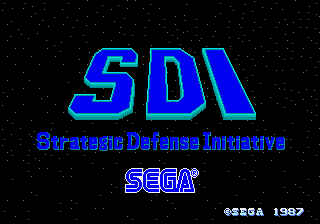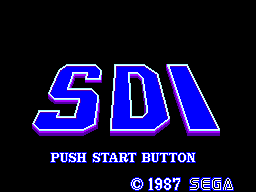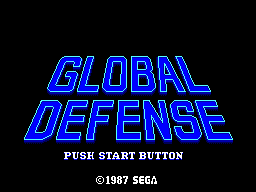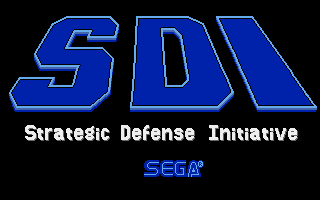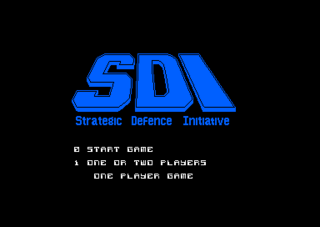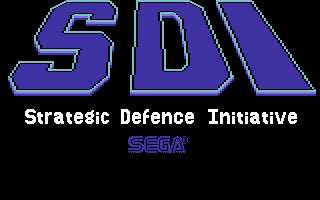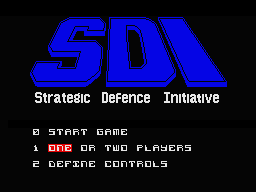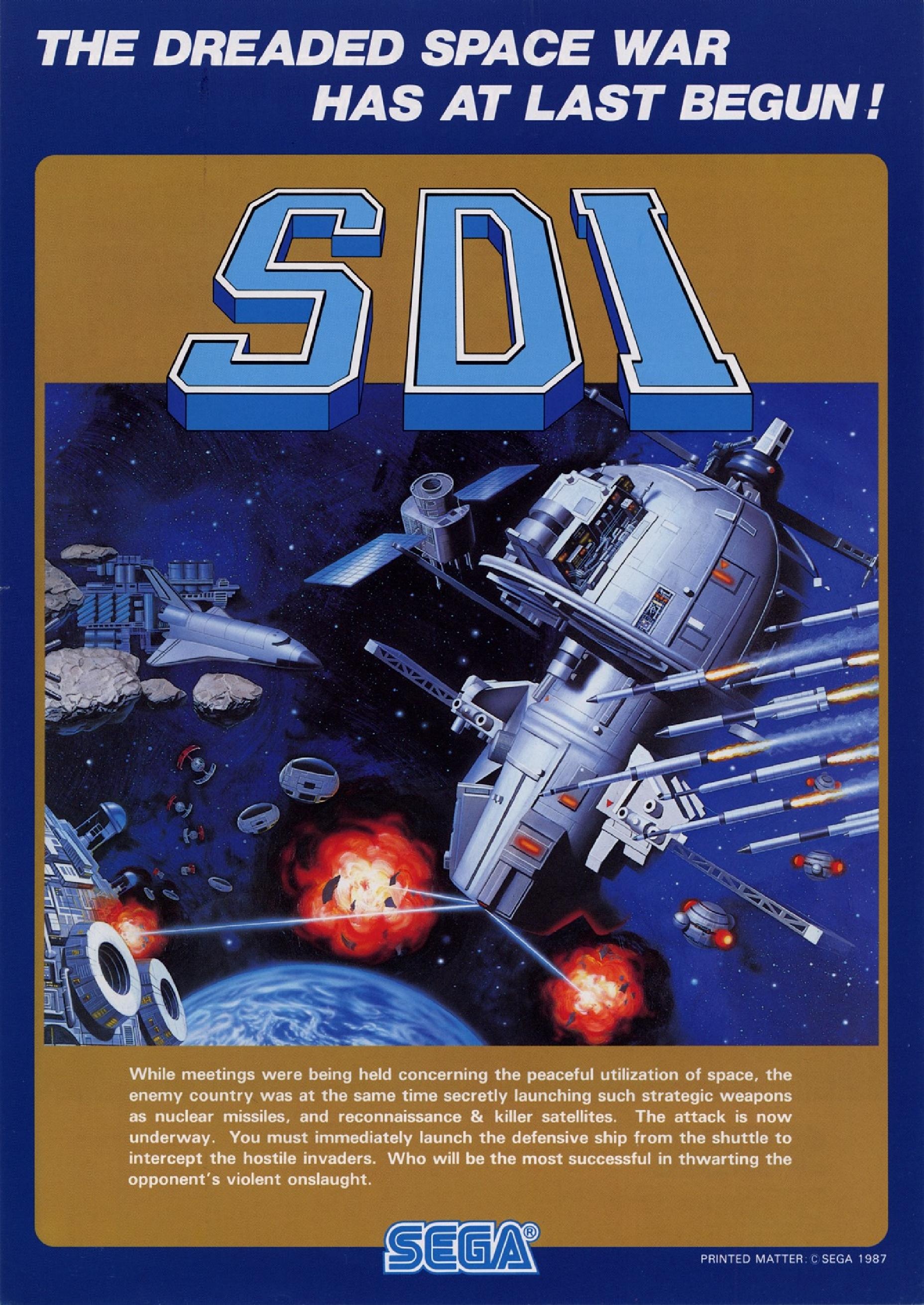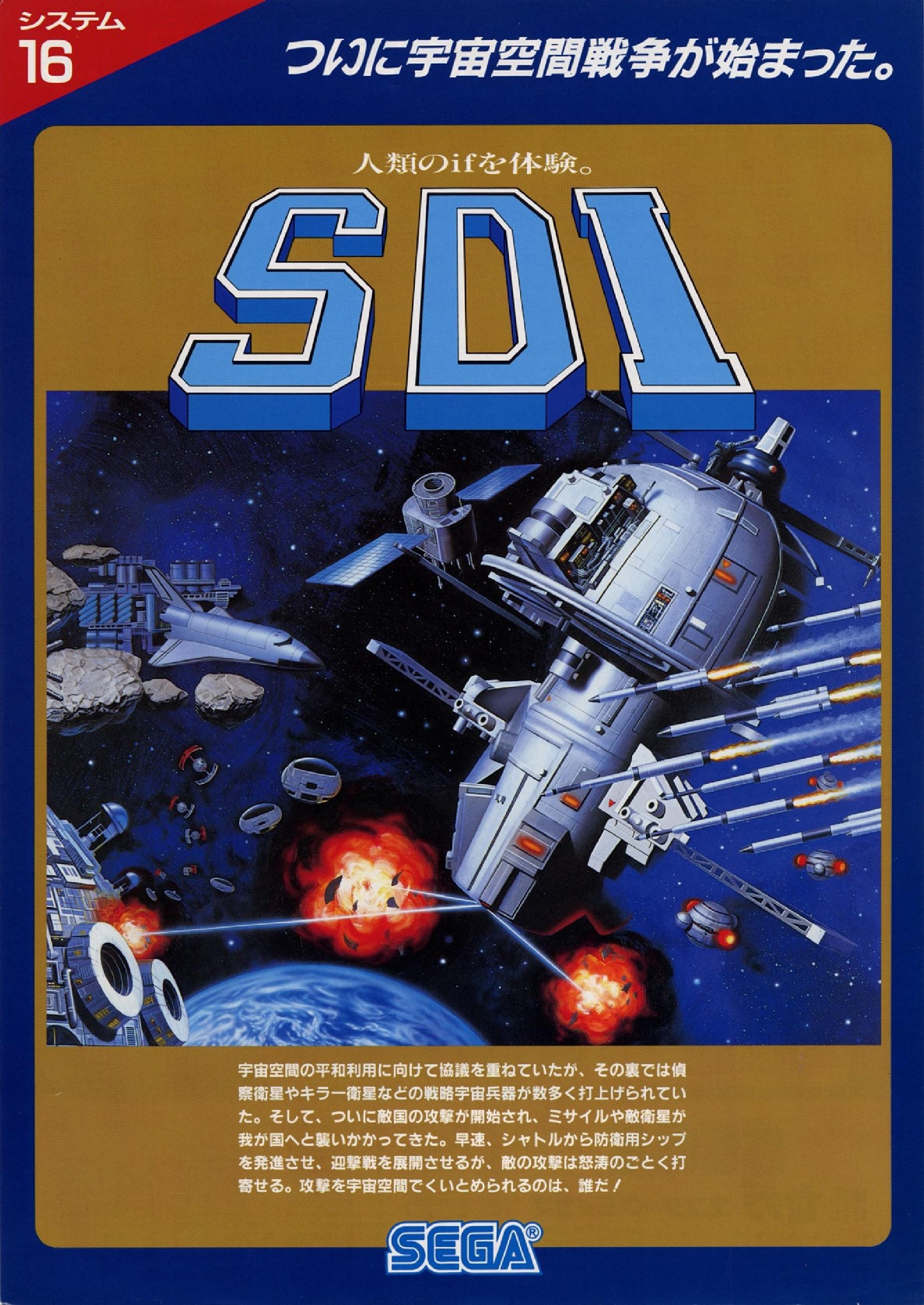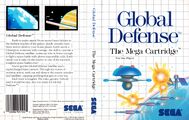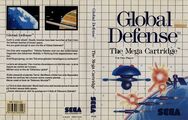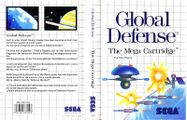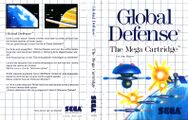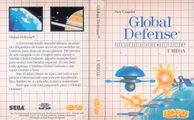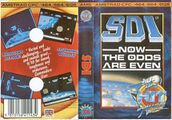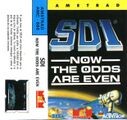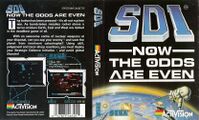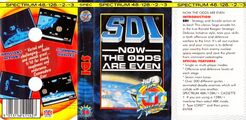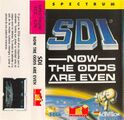SDI: Strategic Defense Initiative
From Sega Retro
| SDI: Strategic Defense Initiative | |||||||||||||||||||||||||||||||||||||||||||||||||||||||||||||||||||||||||||||||||||||||||||||||||||||||||||||||||
|---|---|---|---|---|---|---|---|---|---|---|---|---|---|---|---|---|---|---|---|---|---|---|---|---|---|---|---|---|---|---|---|---|---|---|---|---|---|---|---|---|---|---|---|---|---|---|---|---|---|---|---|---|---|---|---|---|---|---|---|---|---|---|---|---|---|---|---|---|---|---|---|---|---|---|---|---|---|---|---|---|---|---|---|---|---|---|---|---|---|---|---|---|---|---|---|---|---|---|---|---|---|---|---|---|---|---|---|---|---|---|---|---|---|
| System(s): Sega System 16, Sega Master System, Amiga, Amstrad CPC, Atari ST, Commodore 64,ZX Spectrum | |||||||||||||||||||||||||||||||||||||||||||||||||||||||||||||||||||||||||||||||||||||||||||||||||||||||||||||||||
| Publisher: Sega Enterprises, Ltd. Activision (UK) MCM Software (ES) | |||||||||||||||||||||||||||||||||||||||||||||||||||||||||||||||||||||||||||||||||||||||||||||||||||||||||||||||||
| Developer: Sega R&D 1 Sega R&D 2 Software Studios Source Software | |||||||||||||||||||||||||||||||||||||||||||||||||||||||||||||||||||||||||||||||||||||||||||||||||||||||||||||||||
| Distributor: Tonka (US) Ecofilmes (PT) Tec Toy (BR) Samsung (KR) | |||||||||||||||||||||||||||||||||||||||||||||||||||||||||||||||||||||||||||||||||||||||||||||||||||||||||||||||||
| Peripherals supported: FM Sound Unit | |||||||||||||||||||||||||||||||||||||||||||||||||||||||||||||||||||||||||||||||||||||||||||||||||||||||||||||||||
| Genre: Shooting[1] | |||||||||||||||||||||||||||||||||||||||||||||||||||||||||||||||||||||||||||||||||||||||||||||||||||||||||||||||||
| Number of players: 2 | |||||||||||||||||||||||||||||||||||||||||||||||||||||||||||||||||||||||||||||||||||||||||||||||||||||||||||||||||
|
This short article is in need of work. You can help Sega Retro by adding to it.
SDI: Strategic Defense Initiative (エス・ディー・アイ) is a 1987 shoot-'em-up arcade game developed by Sega R&D 1 for the Sega System 16 arcade platform.
Contents
Gameplay
Unusual for its time, SDI has the player assume the role of a satellite, tasked with destroying enemy satellites and missiles. Each level is divided into two "modes" - "offensive" mode, which takes the form of a sidescrolling shoot-'em-up, and "defensive" mode which is built more similarly to Atari's Missile Command. Beating both modes allows the player to progress, however, if the player can destroy all the enemies in offensive mode, defensive mode does not take place.
SDI not only gives the player control over the movement of the satellite, but also its aim. This mechanic was implemented in the original arcade cabinet through the form of a joystick and trackball - the joystick moving the player, the trackball moving the crosshair. On the top of the joystick is a button for firing.
A perfect game of SDI will result in the satellite being replaced with Flicky.
Versions
SDI was ported to the Sega Master System in 1987/1988, where western versions were renamed Global Defense. The Master System version, as well as cutting back on the graphical and audio quality, has to vastly reduce the difficulty of the game to match up with a new control scheme - as the console lacks a trackball, the player needs to switch between moving and aiming during play (holding ![]() while moving the D-Pad allows the satellite to move, otherwise the D-Pad only controls the crosshair). This makes moving and aiming at the same time impossible. However, the U.S. manual lists an alternate two-controller configuration in which the first Control Pad aims and the second Control Pad moves the satellite. When the game is started in this configuration, the satellite fires automatically. To start the game with two Control Pads, either press
while moving the D-Pad allows the satellite to move, otherwise the D-Pad only controls the crosshair). This makes moving and aiming at the same time impossible. However, the U.S. manual lists an alternate two-controller configuration in which the first Control Pad aims and the second Control Pad moves the satellite. When the game is started in this configuration, the satellite fires automatically. To start the game with two Control Pads, either press ![]() +
+![]() or
or ![]() +
+![]() on the second Control Pad[12].
on the second Control Pad[12].
Activision brought the game to home computers in Europe - the Amiga, Amstrad CPC, Atari ST, Commodore 64 and ZX Spectrum (not to be confused with S.D.I., an unrelated game also released for the Amiga and Atari ST).
These days, SDI is often grouped with another arcade game from the era, Quartet. Both were released as part of Volume 21 of the Sega Ages 2500 series, Sega Ages 2500 Series Vol. 21: SDI & Quartet: Sega System 16 Collection for the PlayStation 2. SDI & Quartet: Original Soundtrack contains the official soundtrack of both games.
History
During development, the game was known under the working title of Space Shooting.[13]
Production credits
- Main article: SDI: Strategic Defense Initiative/Production credits.
Digital manuals
Magazine articles
- Main article: SDI: Strategic Defense Initiative/Magazine articles.
Promotional material
also published in:Expand
Physical scans
System 16 version
Master System version
| ExpandSega Retro Average |
|---|
| 74 | |
|---|---|
| Based on 14 reviews | |
| Master System, EU |
|---|
Amiga version
| ExpandSega Retro Average |
|---|
| 54 | |
|---|---|
| Based on 2 reviews | |
| Amiga, UK |
|---|
|
Amstrad CPC version
| ExpandSega Retro Average |
|---|
| 52 | |
|---|---|
| Based on 3 reviews | |
| Amstrad CPC, UK |
|---|
|
| Amstrad CPC, UK (The Hit Squad) |
|---|
Atari ST version
| ExpandSega Retro Average |
|---|
| 71 | |
|---|---|
| Based on 5 reviews | |
| Atari ST, UK |
|---|
|
Commodore 64 version
| ExpandSega Retro Average |
|---|
| 63 | |
|---|---|
| Based on 8 reviews | |
| Commodore 64, UK (cassette) |
|---|
|
| Commodore 64, UK (disk) |
|---|
|
| Commodore 64, UK (The Hit Squad) |
|---|
ZX Spectrum version
| ExpandSega Retro Average |
|---|
| 51 | |
|---|---|
| Based on 5 reviews | |
| ZX Spectrum, UK (The Hit Squad) |
|---|
Technical information
ROM dump status
| System | Hash | Size | Build Date | Source | Comments | |||
|---|---|---|---|---|---|---|---|---|
| ? | 128kB | Cartridge (EU/US) | ||||||
| ? | 128kB | Cartridge (JP) |
References
- ↑ Jump up to: 1.0 1.1 https://sega.jp/history/hard/segamark3/software.html (Wayback Machine: 2020-11-14 21:32)
- ↑ Mega Drive Fan, "May 1992" (JP; 1992-04-xx), page 103
- ↑ Computer Entertainer, "March 1988" (US; 1988-03-19), page 13
- ↑ Computer Gaming World, "August 1988" (US; 1988-xx-xx), page 45
- ↑ File:SMSGamesCatalogueUK.pdf, page 2
- ↑ Jump up to: 6.0 6.1 The Games Machine, "April 1988" (UK; 1988-03-17), page 43
- ↑ The Mastertronic Catalogue (UK; 1988), page 2
- ↑ Jump up to: 8.0 8.1 8.2 8.3 8.4 8.5 8.6 The Games Machine, "January 1989" (UK; 1988-12-15), page 81
- ↑ Jump up to: 9.0 9.1 9.2 9.3 Computer & Video Games, "November 1988" (UK; 1988-10-15), page 43
- ↑ Jump up to: 10.0 10.1 Computer & Video Games, "July 1991" (UK; 1991-06-15), page 81
- ↑ Jump up to: 11.0 11.1 Computer & Video Games, "July 1991" (UK; 1991-06-15), page 85
- ↑ File:Globaldefense sms us manual.pdf, page 12
- ↑ http://www.smspower.org/forums/6961-JapaneseMagazineSegaSpecialIssue198711UnreleasedSegaMarkIIIGames (Wayback Machine: 2016-04-06 08:54)
- ↑ ACE, "November 1988" (UK; 1988-xx-xx), page 72
- ↑ ACE, "November 1988" (UK; 1988-xx-xx), page 49
- ↑ Complete Guide to Consoles, "" (UK; 1989-10-16), page 57
- ↑ Complete Guide to Consoles, "Volume IV" (UK; 1990-11-xx), page 97
- ↑ The Complete Guide to Sega, "" (UK; 1991-05-xx), page 57
- ↑ Console XS, "June/July 1992" (UK; 1992-04-23), page 141
- ↑ Computer & Video Games, "April 1988" (UK; 1988-03-15), page 122
- ↑ Mean Machines Sega, "October 1992" (UK; 1992-09-xx), page 133
- ↑ Power Play, "Ausgabe 4" (DE; 1988-03-21), page 93
- ↑ S: The Sega Magazine, "July 1990" (UK; 1990-06-07), page 12
- ↑ Sega Power, "October 1991" (UK; 1991-09-05), page 57
- ↑ Sega Pro, "Christmas 1991" (UK; 1991-12-12), page 19
- ↑ Sega Pro, "April 1993" (UK; 1993-03-11), page 71
- ↑ User, "Septémvrios 1992" (GR; 1992-0x-xx), page 86
- ↑ The Games Machine, "September 1989" (UK; 1989-08-18), page 91
- ↑ New Computer Express, "July 15, 1989" (UK; 1989-07-13), page 50
- ↑ ACE, "May 1989" (UK; 1989-04-06), page 78
- ↑ Amstrad Computer User, "May 1989" (UK; 1989-xx-xx), page 36
- ↑ Jump up to: 32.0 32.1 32.2 The Games Machine, "May 1989" (UK; 1989-04-20), page 43
- ↑ ACE, "December 1988" (UK; 1988-xx-xx), page 75
- ↑ Computer & Video Games, "December 1988" (UK; 1988-11-xx), page 58
- ↑ The Games Machine, "xxxx 198x" (IT; 1988-12-15), page 36
- ↑ Génération 4, "Décembre 1988" (FR; 1988-1x-xx), page 24
- ↑ Commodore Force, "August 1993" (UK; 1993-06-24), page 20
- ↑ Commodore User, "January 1989" (UK; 1988-12-19), page 64
- ↑ Computer & Video Games, "September 1991" (UK; 1991-08-15), page 88
- ↑ Zzap!64, "March 1989" (UK; 1989-02-16), page 21
- ↑ Zzap!64, "July 1991" (UK; 1991-06-13), page 79
- ↑ Zzap!, "Giugno 1991" (IT; 1991-xx-xx), page 51
- ↑ New Computer Express, "December 24, 1988" (UK; 1988-12-22), page 41
- ↑ Sinclair User, "July 1991" (UK; 1991-06-15), page 42
- ↑ Your Sinclair, "July 1991" (UK; 1991-06-xx), page 58
| CollapseSDI: Strategic Defense Initiative | |
|---|---|
|
Main page | Comparisons | Credits | Magazine articles | Reception
| |
- FM Sound Unit-compatible games
- 2 player games
- All arcade games
- System 16 games
- 1987 System 16 games
- All 1987 games
- Arcade shoot-'em-up games
- All shoot-'em-up games
- JP Master System games
- All JP games
- US Master System games
- All US games
- EU Master System games
- All EU games
- PT Master System games
- All PT games
- UK Master System games
- All UK games
- AU Master System games
- All AU games
- BR Master System games
- All BR games
- KR Master System games
- All KR games
- Master System games
- 1987 Master System games
- Master System shoot-'em-up games
- UK Amiga games
- Amiga games
- 1989 Amiga games
- All 1989 games
- UK Atari ST games
- Atari ST games
- 1988 Atari ST games
- All 1988 games
- ES Amstrad CPC games
- All ES games
- UK Amstrad CPC games
- Amstrad CPC games
- 1988 Amstrad CPC games
- UK Commodore 64 games
- Commodore 64 games
- 1988 Commodore 64 games
- ES ZX Spectrum games
- UK ZX Spectrum games
- ZX Spectrum games
- 1988 ZX Spectrum games
- All games
- Stubs
- Old technical information
- SDI: Strategic Defense Initiative
